Download PDF
https://doi.org/10.47803/rjc.2020.30.2.230
Pavel Platon1, Carmen Ginghina1,2
1 „Prof. Dr. C.C. Iliescu” Emergency Institute for Cardiovascular Diseases, Bucharest, Romania
2 „Carol Davila” University of Medicine and Pharmacy, Bucharest, Romania
Abstract: Percutaneous coronary intervention (PCI) in patients presenting with acute myocardial infarction with ST segment elevation (STEMI) is the standard treatment according to the current European Society of Cardiology Guidelines. Certain aspects of therapy remain under debate, as periodic changes in the guidelines are enabled by new and thorough research. Objectives – We aimed to evaluate clinical and angiographic prognostic factors in patients presenting with acute STEMI treated with primary PCI. Methods – Demographical, clinical and procedural parameters were retrospectively analysed for 303 consecutive STEMI patients successfully treated with primary PCI. Short-term and long-term outcomes were evaluated. Results – Mean follow-up period was 18 ± 12 months. The studied endpoints were mortality, major ad-verse cardiac events (MACEs) and left ventricular ejection fraction (LVEF). At admission TIMI fl ow 0 or 1 was found in 233 (76.9%) of patients and was associated with increased mortality and MACE. Of the studied population, 232 (76.6%) patients had MBG 0 and 52 (17.2%) of patients had MBG 1. In these subgroups of patients mortality was higher than in those with MBG of 2 or 3 (p < 0.05). An increase in TIMI flow and MBG score of at least 2 points after successful reperfusion was correlated with decreased mortality and improvement in the LVEF (p < 0.05). 46 (15.2%) of patients presented with atrial fibrillation while 277 (91.4 %) of patients presented with hypertension at admission. These clinical characteristics were associated with negative survival in STEMI patients (p < 0.05). Conclusion – TIMI fl ow grade and MBG were strong predictors for mortality and cardiovascular events in STEMI patients undergoing primary coronary artery angioplasty. Atrial fibrillation and presence of hypertension predict survival in STEMI patients treated with primary PCI.
Keywords: Acute ST elevation myocardial infarction, percutaneous coronary intervention, angiography, TIMI flow score, myocardial blush grade.
Rezumat: Angioplastia coronariană percutanată primară reprezintă tratamentul de elecţie pentru pacienţii cu infarct miocardic acut cu supradenivelare de segment ST conform ghidurilor actuale de management elaborate de către Societa-tea Europeană de Cardiologie. Aceste ghiduri sunt revizuite periodic, modificările indicaţiilor actuale fi ind susţinute de noi cercetări în domeniu. Obiective – Acest studiu şi-a propus evaluarea factorilor clinici şi angiografici de prognostic pentru pacienţii cu infarct miocardic acut cu supradenivelare de segment ST (STEMI) trataţi prin angioplastie coronariană percu-tanată primară. Metode – Parametrii demografici, clinici şi procedurali au fost analizaţi retrospectiv pentru 303 pacienţi consecutivi cu STEMI trataţi în clinica noastră prin angioplastie coronariană primară. Au fost urmărite complicaţiile, mor-talitatea intraspitalicească precum şi mortalitatea pe termen lung. Rezultate – Perioada medie de urmărire a fost de 18 ± 12 luni. Obiectivele primare studiate au fost mortalitatea, evenimentele cardiovasculare şi fracţia de ejecţie a ventriculului stâng. 232 (76,6%) dintre pacienţi au avut fl ux TIMI 0 sau 1, această caracteristică fiind asociată cu o creştere a mortalităţii şi a evenimentelor cardiovasculare adverse (p < 0,05). 232 (76,6%) dintre pacienţi au avut blush miocardic MBG 0 sau 1, aceste grupe de pacienţi fiind asociate cu o creştere a mortalităţii faţă de pacienţii cu MBG 2 sau 3 (p < 0,05). Dintre paci-enţii incluşi în studiu, 46 (15,2%) au avut fi brilaţie atrială, iar 277 (91,4%) au fost hipertensivi, caracteristice clinice ce s-au asociat cu mortalitate crescută (p < 0,05). Concluzii – Fluxul TIMI şi blush-ul miocardic MBG au fost predictori importanţi pentru mortalitate şi evenimente cardiovasculare adverse la pacienţii cu STEMI ce beneficiază de angioplastie coronariană percutanată primară. Prezenţa fibrilaţiei atriale şi a hipertensiunii arteriale la momentul internării sunt predictori negativi pentru supravieţuire.
Cuvinte cheie: Infarct miocardic acut cu supradenivelare de segment ST, angioplastie coronariană percutanată primară, fl ux TIMI, grad de blush miocardic.
INTRODUCTION
Acute coronary syndromes represent an important healthcare problem in the developing countries1. As the life expectancy in the general population increases, so does the prevalence of coronary artery disease2. The most dangerous phenotype of this disease is re-presented by acute coronary syndromes. The main-stay of therapy for this group of patients equates to obtaining myocardial reperfusion3. The gold standard myocardial reperfusion is achieved by primary percutaneous intervention that is done as fast as possible4. This treatment is associated with low rates of mortality and MACEs compared to medical therapy and fibrinolysis5. Despite our current knowledge and use of state of the art percutaneous coronary intervention, an important number of cases have little or no benefit from the procedure even though angiographic epicardic coronary reperfusion has been succesfully achieved6. Numerous studies succeeded to find accurate clinical and angiographic predictors for mortality or softer endpoints in patients presenting with acute coronary syndromes7. Left ventricular ejection fraction, NYHA functional class, Killip class, TIMI flow score are well established elements which influence the evaluation and prognosis in these patients8.
METHODS
Study population
We performed a single centre retrospective trial at “Prof. Dr. C.C. Iliescu” Institute for Emergency Cardiovascular Diseases in Bucharest. A total of 1895 STEMI patients were admitted in our hospital between January 2015 and December 2016. We selected a subgroup of 324 patients in which the procedure was performed by the same operator with primary PCI within 24 hours from symptom onset. Inclusion criteria were the presence of ischaemic symptoms, ECG changes of acute STEMI according to current European Guidelines and interventional procedure being performed by the same physician. Exclusion criteria were represented by lack of need for an interventional procedure (angiogram not suited for coronary intervention), successful thrombolysis, inadequate angiographic images or lack of follow-up.
Of the 324 patients, 21 were excluded due to the criteria described (9 not suited for intervention, 4 with unusable angiography films and 8 with no follow-up).
The study protocol was reviewed and approved by the Ethics and Institutional Review Board of our clinic. Informed consent was obtained for every patient included in this trial.
Variables
Collected variables consisted of demographic data, clinical characteristics, pre-, post- and procedural angiographic parameters. The demographic and clinical profile consisted of: gender, age, history of hypertension, dyslipidaemia, obesity (BMI >30 kg/m2), diabetes mellitus, smoker status, history of atrial fibrillation, angina, coronary artery syndrome, heart failure, peripheral arterial and cerebrovascular disease. Admission profile included: time from symptom onset, Killip class, ejection fraction, infarcted territory, presence of cardiogenic shock, severity of mitral regurgitation, biological markers (haemoglobin, creatinine, high sensitivity troponin, NTproBNP, CK and CK-MB). Chronic kidney disease was evaluated using estimated glome-rular filtration rate (eGFR) according to the National Kidney Foundation classification9. Amongst the procedural characteristics recorded were: vascular access site, culprit artery, culprit lesion length, vessel diameter, number of affected vessels, grade of stenosis, presence of vessel calcification, number, diameter and length of stents which were used, presence of thrombus, glycoprotein IIb/IIIa inhibitors, need for thromb aspiration and use of intra-aortic balloon pump. Dyna-mic parameters which were observed before and after the procedure were the thrombolysis in myocardial infarction (TIMI) flow grade and the myocardial blush grade (MBG).
All patients were pre-treated with double antiplatelet therapy (aspirin and a P2Y2 inhibitor) and heparin prior to cath-lab admission. Successful PCI procedure was defi ned as TIMI 3 fl ow and a reduction of the culprit lesion stenosis <50%.
Eligible patients were followed over a mean period of 4 years. Post-procedural events such as procedural complications, days of hospitalisation and in-hospital mortality were recorded. After discharge patients were followed up in our clinic at 6-12 months periods and long-term survival data were obtained in some cases through National System Health Records or by contacting the family.
Angiography
Angiography films were retrospectively analysed by the performing physician and another highly trained operator from our clinic with a 3rd consultant being used in cases where there were important divergencies between evaluations. Thrombolysis in myocardial infarction (TIMI) flow was defined according to the grading system established for angiographic assessment of myocardial perfusion in myocardial infarction10. As such, this tool evaluates semi-quantitatively the coronary blood flow in 4 separate categories (TIMI flow 0, 1, 2 and 3). Myocardial blush grade (MBG) was defined according to the system developed by Van‘t Hof et al.11 as contrast filling in the distal coronary bed after passage through the epicardial vessel. This scoring system has 4 grades as follows: MBG 0 – no myocardi-al blush, MBG 1 – minimal myocardial blush, MBG 2 – moderate myocardial blush and MBG 3 – normal myocardial blush. No automated techniques were used for the assessment of TIMI fl ow or myocardial blush. The angiographic parameters were evaluated across the same angiographic views in every patient: 2 views for the left system (LAO cranial and RAO caudal) and in one view for the right coronary artery (LAO). The assessing operators did not have acces to clinical data or post-procedural outcomes during the evaluation. An agreement existed between the 2 operators in 285 (94%) of patients, for the remaining 6% an agreement was reached after consulting with a 3rd operator. This method for evaluation of TIMI blood flow and myocar-dial blush grade was validated in several prior studies with good reproducibility and low inter- and intra-ob-server variability8. The guiding catheter was used for scale and dimension calibration.
The primary endpoint included cardiovascular mortality. Secondary endpoints included recurrent cardiovascular events (MACE), LVEF at discharge, need for reintervention, TIMI fl ow grade and MBG post-PCI.
Statistical analysis
Data were collected using an Excel spreadsheet and subsequently imported into IBM® SPSS® Statistics software version 25.0. Normal distribution of variables was assessed by Shapiro-Wilk test. Quantitative variables were expressed as mean ± SD and compared using the Student t-test, Mann-Whitney U test. Mortality risk was presented using Kaplan-Meier survival function and differences were tested using Log Rank test (univariate) and Cox regression (multivariate). Multivariate logistic regression analysis was used to identify predictive clinical and angiographic factors for outcomes. A p value of <0.05 was used to define statistical significance. No multiplicity adjustments were considered necessary.
RESULTS
A total of 303 patients were included in the study. Mean age for the studied population was 62.35 ± 13.69 (SD) years. 223 (73.6%) were male.
Hypertension was present in 277 (91.4%) of pati-ents, with 48.5% of patients having grade 3 hypertension (SBP >180 mmHg). Atrial fibrillation was present in 46 (15.2%) of patients. The majority (89.1%) of patients had dyslipidaemia while only 42.6% of them were obese. Diabetes was present in 29% of patients, with 3.6% of the patients being insulin dependent diabetics. 164 (54%) were active smokers, 69 (22.8%) were former smokers and 70 (23.1%) were non-smokers. 42% of the population had a history of angina, 8% had a his-tory of acute coronary syndrome, 3.6% had prior PCI and 1.3% had prior CABG. Heart failure was present in 27.4% of patients at admission, the majority (68.7%) of the patients were Killip class I.
Anterior myocardial infarction was observed in 38% of the patients, followed by inferior (30%) and infero-postero-lateral (16.2%) territories. Right ventricular infarction was present in 4.3% of the patients and was associated more frequently with inferior myocardial infarction. The main culprit artery was the left anterior descending artery in 44% of patients the right coronary artery in 40% of patients and the circumflex ar-tery in 14.5% of patients. Significant thrombus burden was seen in 49.8% of patients and thromb aspiration technique was performed in 44.9% of patients.
Cardiogenic shock was present in 27 cases (9%). Cardiogenic shock at presentation was associated with worse outcome and higher mortality. Mild mitral regurgitation was encountered in 44% of patients while severe mitral regurgitation was found in 21% of the studied population.
Femoral arterial access site was used in 92% of the cases and was associated with an increased complication rate.
Identification of factors for the selected endpoints was performed by executing univariate and multivariate logistic regression analysis.
There was no significant survival difference between women and men. Hypertension can predict different survival. Patients who did not have arterial hypertension on admission had a longer survival period and fewer MACEs during follow-up than patients which had grade 3 hypertension (p<0.01).
Atrial fibrillation was an important predictor for mortality and complications (p<0.01). Higher rates of complications (increased bleeding) were observed in this group of patients, probably associated with need for anticoagulation.
Patients with pre-procedural TIMI flow lower than 2 had higher mortality. This subgroup of patients had also more cardiovascular risk factors (more active smokers, higher grade of hypertension, higher rate of dyslipidaemia) and had more extensive coronary artery disease on angiographic evaluation. They had higher LV dysfunction on admission and more frequent involvement of the left descending anterior artery.
Patients presenting within more than 12 hours from onset of the symptoms showed significantly higher mortality during the 2 years follow-up, compared to those with early admission (p=0.0018), as shown in Figure 2.
The survival curves showed a significantly higher risk of mortality in patients with pre-procedural myo-cardial blush grade lower than 2. MACEs free survival rate was significantly higher for patients with myocardial blush grade greater than 2. No difference in survival was observed for patients in whom thromb aspiration was performed.
Figures 3-7 show the cumulative survival by gen-der, presence of atrial fibrillation, hypertension, TIMI flow and myocardial blush grade on admission. For the univariate analysis, all but gender show that they may predict survival (Log rank test). We have further tested if these can independently predict survival. Cox regression shows that all-cause death can be predicted by both TIMI flow and myocardial blush grade lower than 2 as well as increased age, having a diagnosis of hypertension or atrial fibrillation at admission.

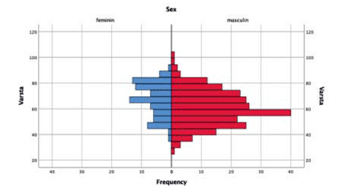
Figure 1. Study population pyramid.
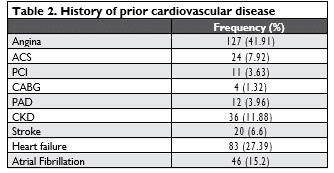
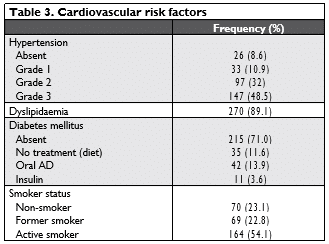
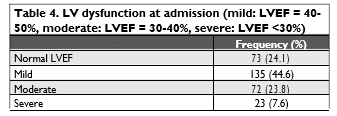
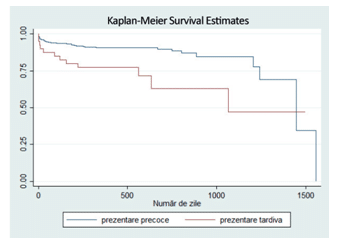
Figure 2. Difference in survival by time of presentation (p=0.0018).
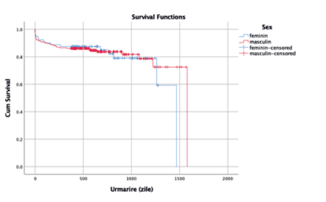
Figure 3. Difference in survival by gender (p>0.05).
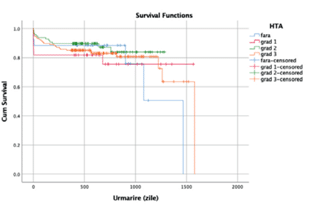
Figure 4. Difference in survival by the presence and grade of hypertension (p<0.01).
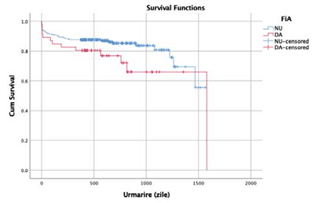
Figure 5. Difference in survival by the presence of atrial fibrillation (p<0.05).
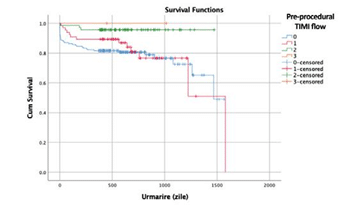
Figure 6. Difference in survival by pre-procedural TIMI flow (p=0.023).
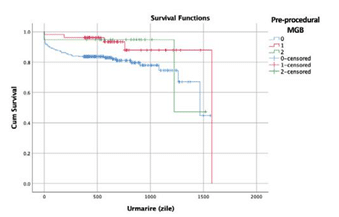
Figure 7. Difference in survival by the pre-procedural myocardial blush grade (p=0.049).
DISCUSSION
STEMI treatment algorithms are constantly updated based on novel research. Defining key mortality predictors is a crucial area of current research.
The cardinal finding of our study demonstrates the important prognostic value of clinical and angiographic characteristics in acute STEMI patients treated with percutaneous coronary intervention.
As shown by other researchers, clinical aspects re-main strong predictors of mortality in STEMI12. Hyper-tension (predominantly grade 3), presence of shock and atrial fibrillation at admission were the most important factors for predicting survival and adverse car-diovascular events in our study.
While TIMI flow grade is a well established para-meter in the current literature with strong correlation for death and MACEs13, myocardial blush grade lacks considerable research to back it up for use as a tool in evaluation of these patients. Although it is a more resource intensive technique that necessitates more time for acquisition and analysis of angiographic images, myocardial blush grade is useful for evaluating prognosis in patients with TIMI fl ow 3. These patients have successful reperfusion with normal flow in the epicardial coronary artery, but some studies suggested that prognosis is different in this subgroup. One study demonstrated that MBG is related to TIMI flow and that myocardial perfusion can be inadequate (MBG of 0 or 1) even when TIMI flow 3 is present14. As such, MBG can be a useful tool for evaluation of patients with poorer prognosis amongst those with TIMI 3 flow after reperfusion. In our study, pre and post-procedural myocardial blush grade was correlated TIMI flow, mitral regurgitation severity, mortality and MACEs.
STUDY LIMITATIONS
This study is a retrospective, unrandomized clinical study, so results are vulnerable to selection errors. It was performed in a single tertiary centre, with expertise in STEMI treatment and results should be validated in a large, multi-centercentre study. Another possible limitation of this analysis is the subjective method of blush quantification, operator and vendor dependent. Comparison with delayed-enhanced cardiac magnetic resonance assessment of microvascular obstruction could surpass this limitation in a future study.
CONCLUSION
In summary, our research showed that pre-procedural TIMI flow and myocardial blush grade were strong predictors for mortality in STEMI patients treated with primary PCI. Atrial fibrillation and presence of hypertension at admission predict survival in STEMI patients treated with primary PCI.
Conflict of interest: none declared.
References
1. Kumar A, Cannon CP. Acute coronary syndromes: Diagnosis and management, part I. Mayo Clin Proc. 2009;84(10):917-938. doi:10. 4065/84.10.917
2. The World Health Organization. The top ten causes of death fact sheet. http://www.who.int/mediacentre/factsheets/fs310/en/index. html. Published 2015.
3. Ibanez B, James S, Agewall S, et al. 2017 ESC Guidelines for the man-agement of acute myocardial infarction in patients presenting with ST-segment elevation. Eur Heart J. 2018;39(2):119-177. doi:10.1093/ eurheartj/ehx393
4. Terkelsen CJ, Christiansen EH, Sørensen JT, et al. Primary PCI as the preferred reperfusion therapy in STEMI: it is a matter of time. Heart. 2009;95(5):362 LP – 369. doi:10.1136/hrt.2007.139493
5. Armstrong PW, Gershlick AH, Goldstein P, et al. Fibrinolysis or pri-mary PCI in ST-segment elevation myocardial infarction. N Engl J Med. 2013;368(15):1379-1387. doi:10.1056/NEJMoa1301092
6. Ambrosio G, Weisman HF, Mannisi JA, Becker LC. Progressive im-pairment of regional myocardial perfusion after initial restoration of postischemic blood flow. Circulation. 1989;80(6):1846-1861. doi:10. 1161/01.CIR.80.6.1846
7. Ashraf T, Khan MN, Afaque SM, et al. Clinical and procedural pre-dictors and short-term survival of the patients with no reflow phe-nomenon after primary percutaneous coronary intervention. Int J Cardiol. 2019;(xxxx):7-11. doi:10.1016/j.ijcard.2019.07.067
8. Addala S, Grines CL, Dixon SR, et al. Predicting mortality in patients with ST-elevation myocardial infarction treated with primary per-cutaneous coronary intervention (PAMI risk score). Am J Cardiol. 2004;93(5):629-632. doi:10.1016/j.amjcard.2003.11.036
9. Evaluation D. Correction: National Kidney Foundation Practice Guidelines for Chronic Kidney Disease. Ann Intern Med. 2003; 139
(7):605. doi:10.7326/0003-4819-139-7-200310070-00029
10. Appleby MA, Angeja BG, Dauterman K, Gibson CM. Angiograph-ic assessment of myocardial perfusion: TIMI myocardial perfusion (TMP) grading system. Heart. 2001;86(5):485-486.
11. Van ’t Hof AWJ, Liem A, Suryapranata H, Hoorntje JCA, De Boer MJ, Zijlstra F. Angiographic assessment of myocardial reperfusion in patients treated with primary angioplasty for acute myocardial infarction: Myocardial blush grade. Circulation. 1998;97(23):2302-2306. doi:10.1161/01.CIR.97.23.2302
12. Zorbozan O, Cevik AA, Acar N, et al. Predictors of mortality in ST-elevation MI patients. Med (United States). 2018;97(9):1-5. doi:10.1097/MD.0000000000010065
13. De Luca G, Parodi G, Sciagrà R, et al. Preprocedural TIMI flow and infarct size in STEMI undergoing primary angioplasty. J Thromb Thrombolysis. 2014;38(1):81-86. doi:10.1007/s11239-013-0977-x
14. Rasoul S, Dambrink JHE, Breeman A, Elvan A, Van ’t Hof AWJ. The relation between myocardial blush grade and myocardial contrast echocardiography: Which one is a better predictor of myocardial damage? Netherlands Hear J. 2010;18(1):25-30.
 This work is licensed under a
This work is licensed under a